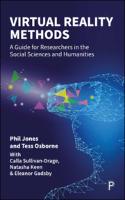Virtual Reality Methods
A Guide for Researchers in the Social Sciences and Humanities
| dc.contributor.author | Jones, Phil | |
| dc.contributor.author | Osborne, Tess | |
| dc.contributor.author | Sullivan-Drage, Calla | |
| dc.contributor.author | Keen, Natasha | |
| dc.contributor.author | Gadsby, Eleanor | |
| dc.date.accessioned | 2022-06-22T09:07:36Z | |
| dc.date.available | 2022-06-22T09:07:36Z | |
| dc.date.issued | 2022 | |
| dc.identifier | OCN: 1328132145 | |
| dc.identifier.uri | https://library.oapen.org/handle/20.500.12657/57076 | |
| dc.description.abstract | ePDF and ePUB available Open Access under CC-BY-NC-ND licence. Since the mid-2010s, virtual reality (VR) technology has advanced rapidly. This book explores the many opportunities that VR can offer for humanities and social sciences researchers. The book provides a user-friendly, non-technical methods guide to using ready-made VR content and 360° video as well as creating custom materials. It examines the advantages and disadvantages of different approaches to using VR, providing helpful, real-world examples of how researchers have used the technology. | en_US |
| dc.language | English | en_US |
| dc.subject.other | Creative research methods; Digital methods; Immersive environments; New technology; Research methods; Social research methods; Virtual reality | en_US |
| dc.title | Virtual Reality Methods | en_US |
| dc.title.alternative | A Guide for Researchers in the Social Sciences and Humanities | en_US |
| dc.type | book | |
| oapen.identifier.doi | 10.47674/9781447360773 | en_US |
| oapen.relation.isPublishedBy | f394f44e-e957-4b77-91b6-32fe9c22978a | en_US |
| oapen.relation.isbn | 9781447360759 | en_US |
| oapen.pages | 158 | en_US |
| oapen.place.publication | Bristol | en_US |

